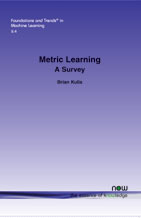Metric Learning: A Survey
By Brian Kulis, Ohio State University, USA, kulis@cse.ohio-state.edu
Abstract
The metric learning problem is concerned with learning a distance function tuned to a particular task, and has been shown to be useful when used in conjunction with nearest-neighbor methods and other techniques that rely on distances or similarities. This survey presents an overview of existing research in metric learning, including recent progress on scaling to high-dimensional feature spaces and to data sets with an extremely large number of data points. A goal of the survey is to present as unified as possible a framework under which existing research on metric learning can be cast. The first part of the survey focuses on linear metric learning approaches, mainly concentrating on the class of Mahalanobis distance learning methods. We then discuss nonlinear metric learning approaches, focusing on the connections between the nonlinear and linear approaches. Finally, we discuss extensions of metric learning, as well as applications to a variety of problems in computer vision, text analysis, program analysis, and multimedia.
Metric Learning
The metric learning problem is concerned with learning a distance function tuned to a particular task, and has been shown to be useful when used in conjunction with nearest-neighbor methods and other techniques that rely on distances or similarities.
Metric Learning: A Survey presents an overview of existing research in this topic, including recent progress on scaling to high-dimensional feature spaces and to data sets with an extremely large number of data points. It presents as unified a framework as possible under which existing research on metric learning can be cast.
The monograph starts out by focusing on linear metric learning approaches, and mainly concentrates on the class of Mahalanobis distance learning methods. It then discusses nonlinear metric learning approaches, focusing on the connections between the non-linear and linear approaches. Finally, it discusses extensions of metric learning, as well as applications to a variety of problems in computer vision, text analysis, program analysis, and multimedia.
Metric Learning: A Survey is an ideal reference for anyone interested in the metric learning problem. It synthesizes much of the recent work in the area and it is hoped that it will inspire new algorithms and applications.
